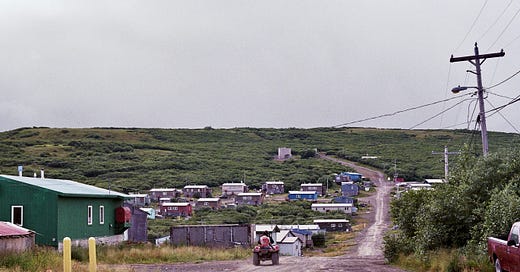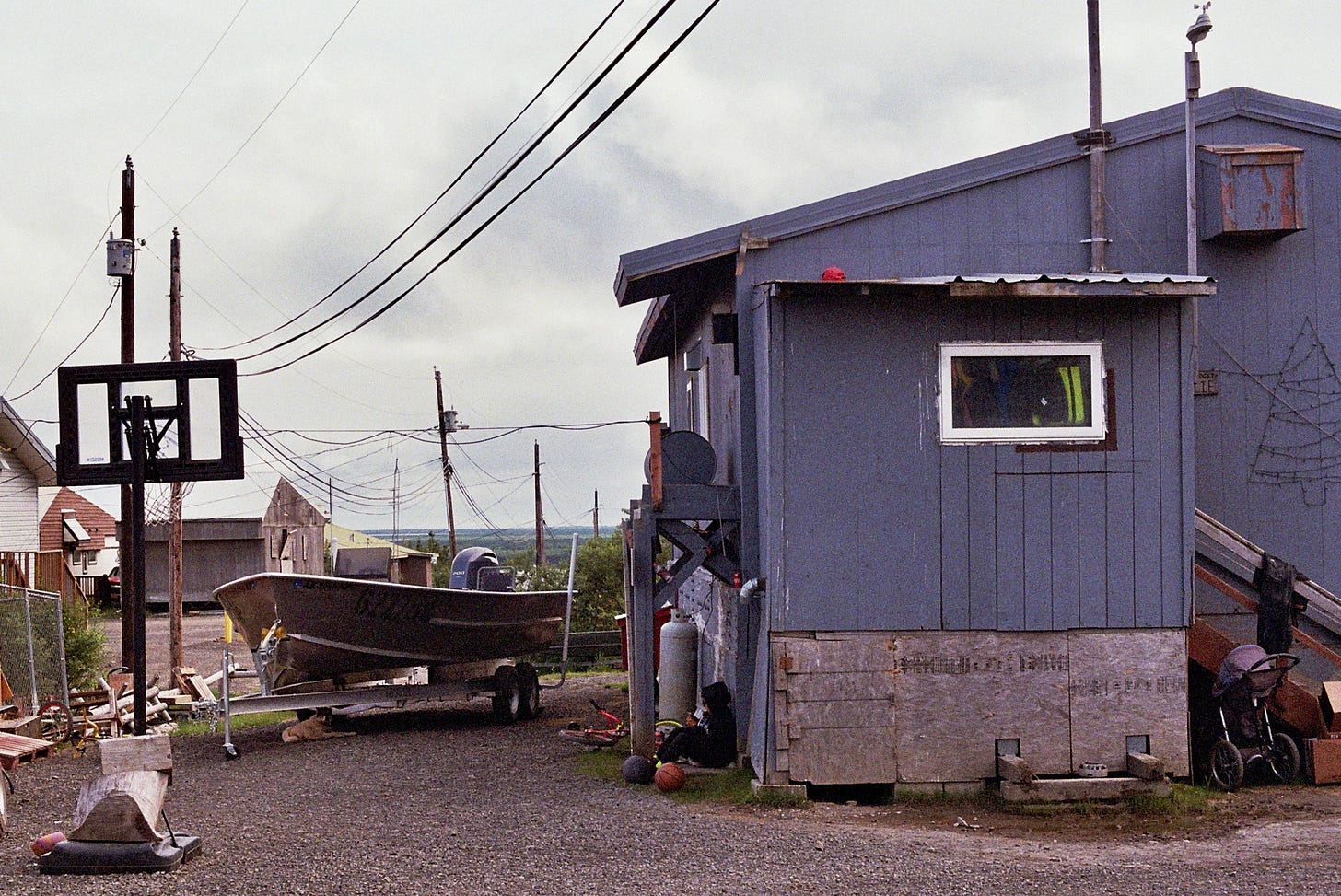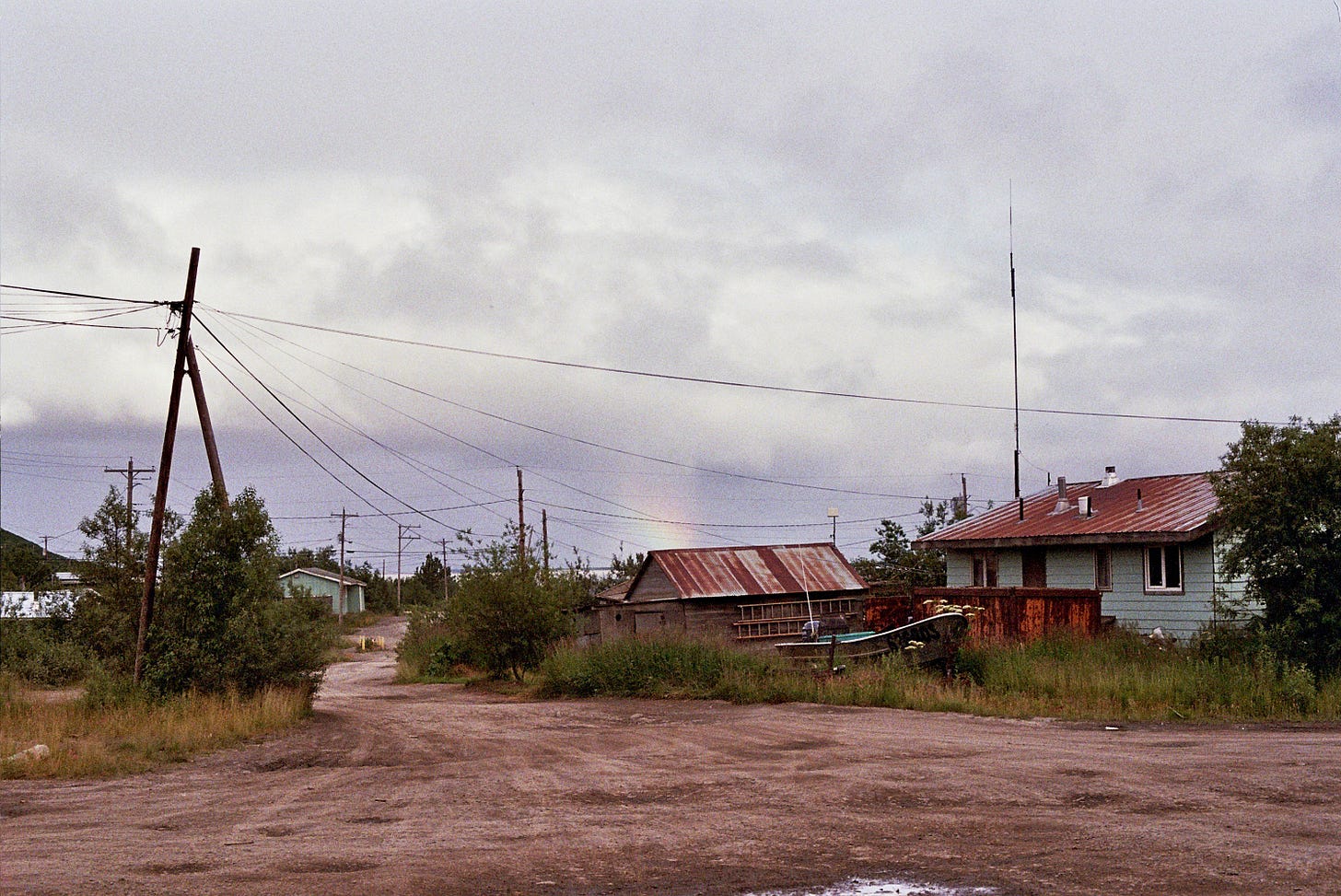I Knew I Had the Story When I Smelled the Mold
Scrambling to make climate change in Alaska feel real in my latest for The Washington Post
A behind-the-scenes of my latest for The Washington Post, Housing in Alaska Can’t Survive Climate Change. This Group Is Trying a New Model, supported by the Pulitzer Center.
MOUNTAIN VILLAGE, ALASKA — I knew I had the story when I smelled the mold. The damp wooden floorboards of the vestibule drooped as I entered a 28 x 36 ft wooden house, a structure so worn it slouched like a package left in the rain. It was dark. Plastic sheets, taped over windows in lieu of glass, slapped in the wind. The insulation, whiplashed by decades of Arctic temperature fluctuations, gave off a stench so musty I stopped breathing through my nose. It still settled on my tongue.
On a mattress on the floor sat Francis Waskey, a gentle 55-year-old Yupik man wearing a winter coat, who rose to greet me and my guide, Ron, with big bright eyes and a smile of black teeth. Francis was in the final stages of packing up his home where he grew up with his family and remained after his parents passed. Over the roar of lawn mowers outside cutting down the poplars and poison ivy around the house, preparing it for demolition in a few days, Francis told me about his home’s losing battle to the thawing permafrost—the semi-frozen soil that underlays 80% of Alaska, including Mountain Village. The house used to stand four feet above ground on piles. Now, they’ve completely sunk into the muck underneath. Over the years, Francis has attempted to keep the house together—using empty propane tanks as makeshift piles and duct tape to patch up the splitting floor. But there’s nothing he can do about the mold.
“The last couple days I could hear the house shifting and cracking,” said Francis, who became the lead character of my latest climate story for The Washington Post. “It sounds like someone’s trying to get into my house.”
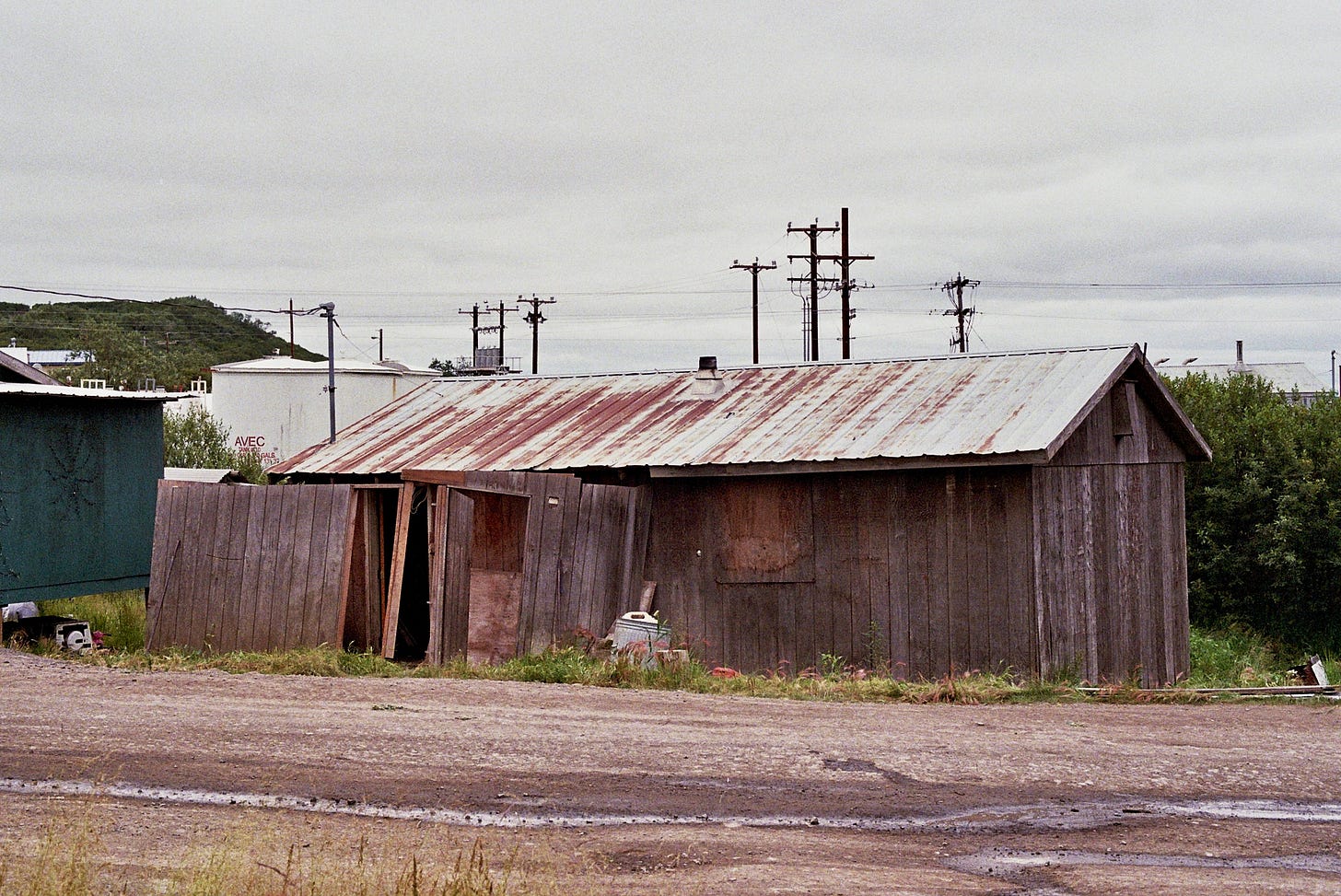
Up until that point, I was nervous as hell about this story. The night before, I laid in my twin bed, high on midnight sun and listening to flies buzz their way to death on the sticky fly tape dangling from the window, wondering how I was going to find the right narrative to tell this story. I was sleeping in what’s locally known as the “Hilton,” a motel-like work station in Mountain Village, a Yupik village of 855 people on the Yukon River Delta that is only accessible by boat or bush plane. The Hilton was set up for outsiders like me, and it’s the only accommodation in town.
I came here to report a story for The Post about the Cold Climate Housing Research Center (CCHRC), a part of the National Renewable Energy Laboratory (NREL) based in Fairbanks, Alaska, that is collaborating with Native communities to adapt homes to the changing climate, including six new ones in Mountain Village (you should probably read that first). Francis’ home, like so many across Alaska, was thrown up during the economic boom of the Trans-Alaska Pipeline, which prompted a building frenzy of homes in the 1970’s that were never meant to thrive in the brutal Far North. Now, houses are failing en masse, contributing to exorbitant heating bills, extreme overcrowding, and some of the highest rates of respiratory illnesses among Native children in the nation. As thawing permafrost accelerates the demise of these homes, CCHRC is working to undo the faulty architecture of the past, and brace homes for a future of uncertainty.
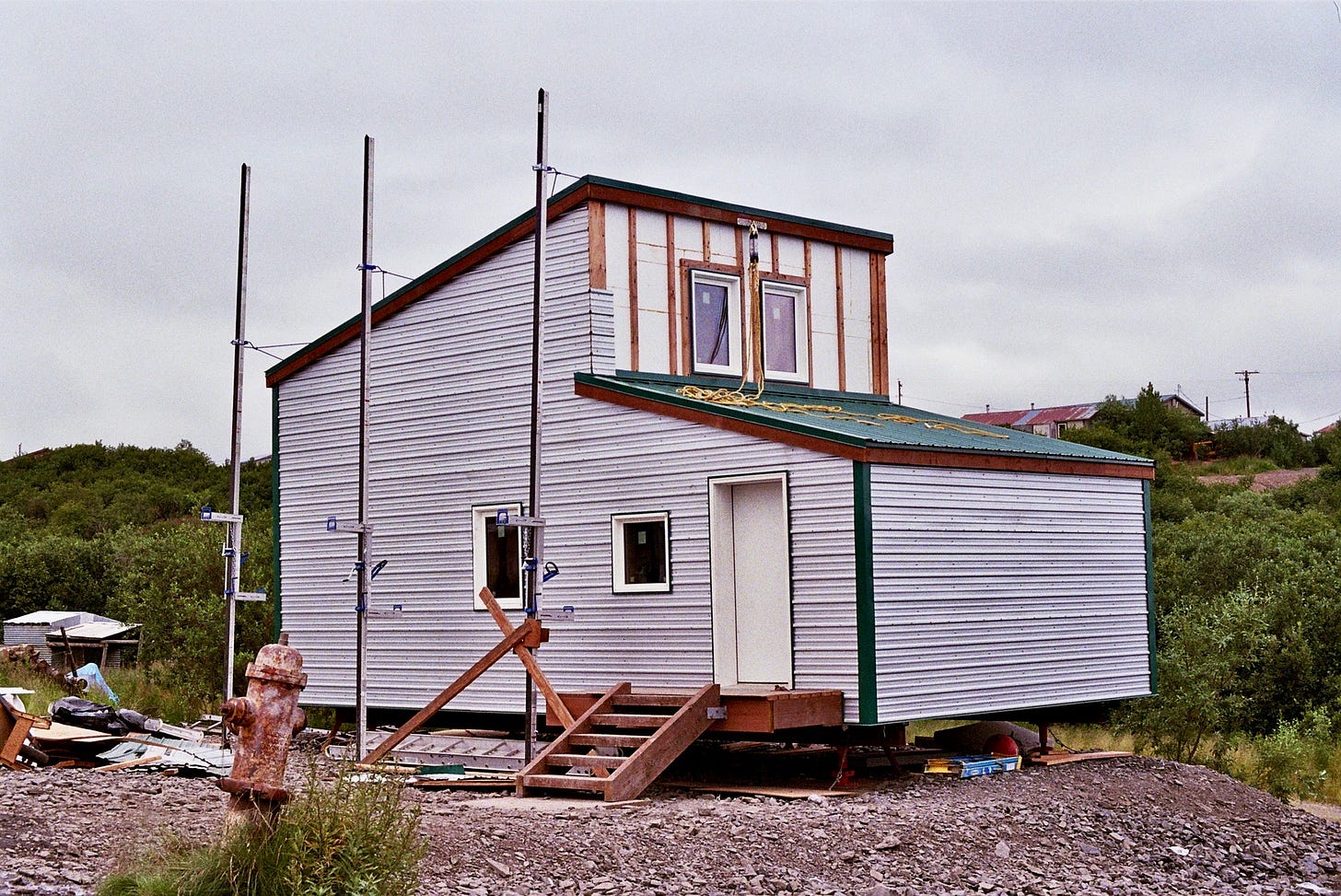
I spent months preparing for this trip to Mountain Village. I interviewed folks about the energy transition, Alaskan politics, thawing permafrost, building science—all the really boring stuff that would make any reader’s eyes glaze over (myself included). I did so much reporting that I had a 7-page outline ready to go before I even arrived (according to a former editor, I suffer from chronic over-reporting. This is not a humble brag). I’m sure if you were to ask the CCHRC researchers how I was to work with, they would say something along the lines of, “She wouldn't leave us alone.”
As foundational as these subjects are for this story, there is nothing sexy or narratively engaging about construction. My 50+ pages of pre-reporting notes were not going to tell this story. The people in Mountain Village were. And so I laid awake, now really identifying with the dying flies, worrying about how, or even if, I would find the narrative to carry a story with so many intersecting crises, whether people would talk to me, whether it would be compelling, whether I would do the story or the grant justice. I am batshit obsessive about structure. So until the narrative comes, it will torment me while I’m in the shower, brushing my hair, hand-grinding coffee beans in the morning...because until there is an arc, there is no story.
That is always the challenge in narrative journalism. But it’s especially difficult when it comes to stories about climate change—this nebulous, monstrous, slow-moving disaster that is simply too vast for words to capture. Us humans are not good with vast. This is something climate journalists are working to figure out, and something I explored for Nieman Reports last year in Australia in the wake of the bushfires: how do you make this massive thing feel urgent, present, and personal? In this case, I had to not only get into the lives of the people of Mountain Village, but inside their homes, and essentially ask, as a stranger, “So, how’s it feel living in a house that’s falling apart?” That is a wildly invasive and uncomfortable ask, but that is what this story called for.
As I adjusted my blackout eye mask—a must in Arctic summertime—I tried to reassure myself that this was only day one of my assignment, that it takes time to forge relationships while reporting. I thought back to the cover story I did with Adam on the drought in Australia. Damn did we put in the time for that. We camped on a pasture for two nights and went cattle droving on horseback. We hung out on the patios of farmers in the blistering heat and ate bubble-and-squeak (a weird egg vegetable dish I try not to think about). We drank lots of beer with the locals and slept in the pub. But I had two weeks for that assignment. In Mountain Village, I had three days.
The vibe in the Australian bush is also very different from that of Alaska. Australian bushies, especially those in the pub, went wild over me, this young American woman roving around the bush (very exotic), and were excited to hang out and talk about Trump. But in Mountain Village, the residents were generally much shyer, which made shared experiences all the more crucial. But because of Covid, there were few to be had, not even meals. So the whole time, I ate in the work station, subsisting on peanut butter and packages of freeze-dried food containing ~72%DV of sodium and 52 grams of protein (I highly recommend the lasagna). I roamed around the village but I couldn’t just walk up to anyone. As an outsider, I needed to be introduced. So when the tribal office put in some calls for me on the first afternoon and nobody was interested in talking to me, I panicked.
I woke up on day two at 6:30am to a blinding overcast sky with no plan other than to say yes to anything. As I got dressed into my daily uniform of rain pants, rain coat, and Merrell’s (the boots—not the slide-ons), I was already playing out an exchange with my editor, trying to explain how I came all this way and couldn’t find anyone to speak to. That morning, I hitched a bumpy ride on an ATV (the main mode of transport) downhill to the tribal office where I ran into Ron Lawrence, a house maintenance worker with the tribe—the same man who had picked me up from the airport the day before. Ron had first struck me as shy, but then he cracked a few jokes under his thick Alaskan accent (Minnesotan but more cavernous), and I took a liking to him. He asked me what I was doing today and I told him I was trying to meet some residents. “Want me to show you around?”
Thrilled and relieved, I leapt into his pick-up truck with barred windows in the back—it doubles as a police car—and spent the next couple hours driving around Mountain Village, a name that derives from the town’s hillside that is far from a mountain, but is the tallest peak for miles if you’re boating down the Yukon. The drive through town was more of a crawl, as Ron slowed to point out hints of the housing crisis on every lot: rotting insulation here, crooked piles there, a floor caving here. We got to Ron’s house, which we crouched underneath, swinging between piles so he could show me where the floor used to sag (obviously I slammed my head into a post). Ron explained that he could tell when the ground had shifted when the porch door jammed shut. Sometimes when his granddaughter plays with a ball, it’ll bounce back at an angle. Poor insulation causes pipes to freeze, so Ron pays a hefty bill just to run the heat all night. “I've got toddlers in there,” he said. “They get up and want their bottle.”
When I heard that line, I felt my heart collapse like the foundation of Ron’s neighbor. I was sure that Ron was my guy for the story. Fear of not being able to feed your grandchild—I mean, how much more real could climate change get than that?
Then, speaking of shifting houses, Ron mentioned that he and a crew recently had to move one themselves—a house just down by the river. “The power line was pretty much the only thing that was holding this house from continuing on to the river,” he said. My journalistic radar blared so hard I felt my neck snap.
“Oh, wow. Where was that?”
“That was way down on the riverfront.”
“Can I see that house?”
We hopped back in the car and arrived at a little house precariously perched on a slope facing the Yukon. We walked down the hill, where Ron made a 45º angle out of his hand to show me how much the piles had bowed before they hooked up the house to a truck...and jolted it back into place. Then Ron mentioned that a single man was moving into this little house...because his own was being demolished...in a matter of days...for a CCHRC home to be built...yes yes yes….the feeling of cracking a Rubix cube took hold of me (which I have never done but can imagine is intellectually orgasmic) — “Can we go meet him?”
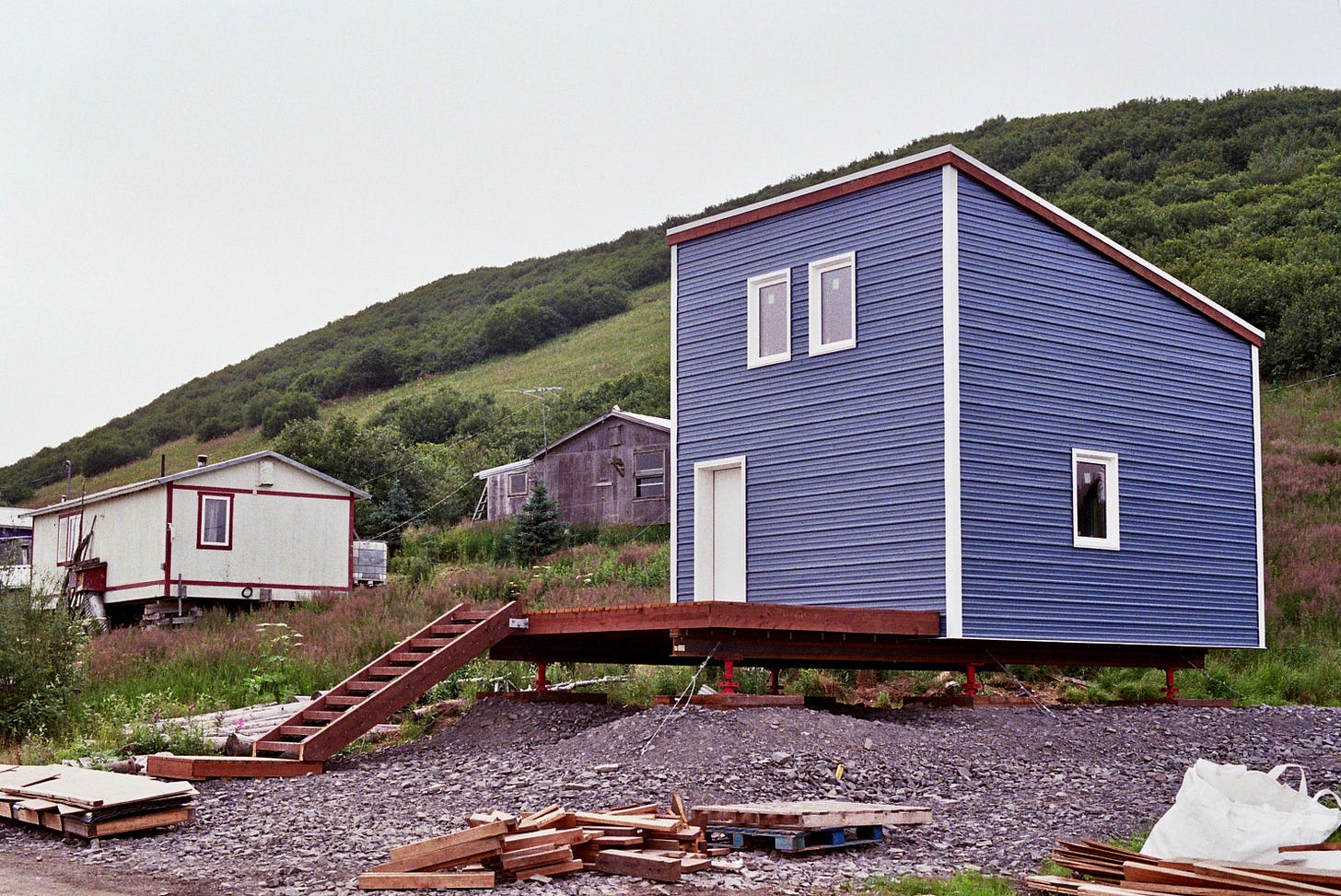
So there Ron and I were, standing in this sinking house with Francis, a man who had lived here his entire life, breathing in mold and trying to stay warm, as the world quite literally deteriorated around him—and took his house with it. This was it. I knew I had to come back. When I heard the demolition would occur on Monday, I extended my stay by two days just so I could watch it myself.
The following day, a Friday morning, I walked back to Francis’ house alone to watch the crew prepare it for demolition. I felt nervous again. Part of me was chiding myself for being such a fucking gross vulture, barging my way into an innocent man’s life. What is wrong with you? Do you have no decency? The journalist in me was springing with energy. What a narrative arc. This is exactly what you came here to do. How can people understand the urgency of climate change if they don't see what you see?
I knocked, and Francis greeted me with a smile. He wasn’t chatty, but he was warm, and I stood with him to watch as a construction team crowbarred plywood from the walls, and unearthed the source of the musty stench: black mold swirling through spongy yellow insulation like marble cake. After years of living here, Francis said stairs and moving stuff now leave him winded. When I asked him how he felt about losing his childhood home, he laughed. He felt no remorse.
A little later on, two of his sisters came over, Tatiana and Rose. They grew up in this house too, and were much more emotional about losing it than Francis. “So many memories, they make me want to cry,” said Rose. Tatiana did. Then there was a shriek from the kitchen. “Look!” said Tatiana. “I found my mom’s uluaq!” She returned from the empty kitchen holding a rusty knife made of caribou antler.
“I made that for her,” said Francis, referring to his mom, many years ago.
“And now he gives it to me!” Tatiana said laughing, clutching the uluaq. She bound towards him with a hug. “Thank you, thank you.” I stood there quietly, struggling to hold back my own teary smile.
Finally the day came for the demolition. I returned at 9am to a crew pulling down the house, sending poofs of rotten yellow insulation into the air and my eyes into a raging itching fit. I went back to the Hilton to scarf down a bag of freeze-dried oatmeal for lunch, and returned to the site again in the afternoon, hoping that Francis would show up to watch the house fall so I could capture his reaction to it. The bulldozer tried to jam its fork into the foundation, but the vehicle got stuck in the mud, so they brought in a truck to drag the house out. But the floor was so damp that it tore in half, revealing a rusty barrel and crinkled trash bin, placed there years ago to support the house.
3pm turned to 4pm. Rose showed up to wish goodbye to the house, but Francis did not. 4pm turned to 5pm. I got restless, worrying that the arc of the story wouldn’t hold if Francis didn’t show. I needed one final quote from him. Anger! Sadness! Relief! Something, anything, to tie the story together. But as the crew scooped up black insulation flinging around the road and from the ditch where his house once stood, I realized that his silence said it all.

